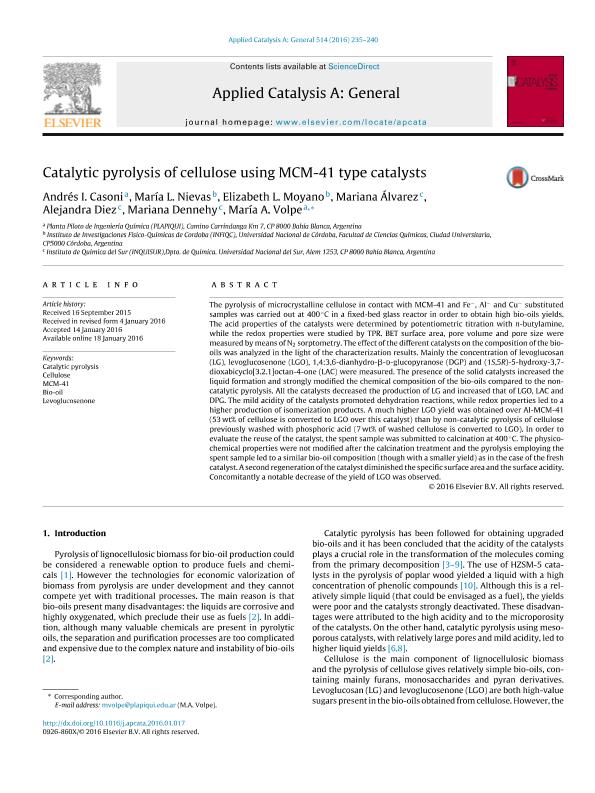Artículo
Catalytic pyrolysis of cellulose employing MCM-41 type catalysts
Casoni, Andrés Iván ; Nieva, María Luz
; Nieva, María Luz ; Moyano, Elizabeth Laura
; Moyano, Elizabeth Laura ; Alvarez, Mariana
; Alvarez, Mariana ; Diez, Alejandra
; Diez, Alejandra ; Dennehy, Mariana; Volpe, María Alicia
; Dennehy, Mariana; Volpe, María Alicia
 ; Nieva, María Luz
; Nieva, María Luz ; Moyano, Elizabeth Laura
; Moyano, Elizabeth Laura ; Alvarez, Mariana
; Alvarez, Mariana ; Diez, Alejandra
; Diez, Alejandra ; Dennehy, Mariana; Volpe, María Alicia
; Dennehy, Mariana; Volpe, María Alicia
Fecha de publicación:
01/2016
Editorial:
Elsevier Science
Revista:
Applied Catalysis A: General
ISSN:
0926-860X
Idioma:
Inglés
Tipo de recurso:
Artículo publicado
Clasificación temática:
Resumen
The pyrolysis of microcrystalline cellulose in contact with MCM-41 and Fe−, Al− and Cu− substituted samples was carried out at 400◦C in a fixed-bed glass reactor in order to obtain high bio-oils yields.The acid properties of the catalysts were determined by potentiometric titration with n-butylamine,while the redox properties were studied by TPR. BET surface area, pore volume and pore size were measured by means of N2 sorptometry. The effect of the different catalysts on the composition of the bio-oils was analyzed in the light of the characterization results. Mainly the concentration of levoglucosan(LG), levoglucosenone (LGO), 1,4:3,6-dianhydrogo-B-D-glucopyranose (DGP) and (1S,5R)-5-hydroxy-3,7-dioxabicyclo[3.2.1]octan-4-one (LAC) were measured. The presence of the solid catalysts increased theliquid formation and strongly modified the chemical composition of the bio-oils compared to the non-catalytic pyrolysis. All the catalysts decreased the production of LG and increased that of LGO, LAC and DPG. The mild acidity of the catalysts promoted dehydration reactions, while redox properties led to ahigher production of isomerization products. A much higher LGO yield was obtained over Al-MCM-41(53 wt% of cellulose is converted to LGO over this catalyst) than by non-catalytic pyrolysis of cellulose previously washed with phosphoric acid (7 wt% of washed cellulose is converted to LGO). In order to evaluate the reuse of the catalyst, the spent sample was submitted to calcination at 400◦C. The physico-chemical properties were not modified after the calcination treatment and the pyrolysis employing the spent sample led to a similar bio-oil composition (though with a smaller yield) as in the case of the fresh catalyst. A second regeneration of the catalyst diminished the specific surface area and the surface acidity.Concomitantly a notable decrease of the yield of LGO was observed.
Palabras clave:
Catalytic Pyrolysis
,
Cellulose
,
Mcm-41
,
Bio-Oil
,
Levoglucosenone
Archivos asociados
Licencia
Identificadores
Colecciones
Articulos(PLAPIQUI)
Articulos de PLANTA PILOTO DE INGENIERIA QUIMICA (I)
Articulos de PLANTA PILOTO DE INGENIERIA QUIMICA (I)
Citación
Casoni, Andrés Iván; Nieva, María Luz; Moyano, Elizabeth Laura; Alvarez, Mariana; Diez, Alejandra; et al.; Catalytic pyrolysis of cellulose employing MCM-41 type catalysts; Elsevier Science; Applied Catalysis A: General; 514; 1-2016; 235-240
Compartir
Altmétricas



